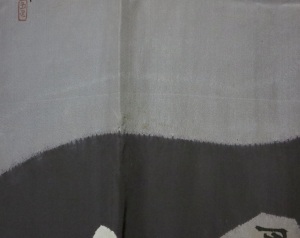Man’s nagajuban (long underkimono)
Silk
Shibori, hand painted
This juban is presented in honor of the year of the horse, which begins today, according to the Chinese lunar calendar. Traditional Chinese cosmology groups the years into twelve year cycles, each represented by an animal. The twelve year cycles are grouped by the five elements – earth, air, wind, fire and water – so a complete cycle of all animals and all elements takes sixty years. This is the year of the wooden horse; 2002 was the year of the water horse.
The back of this nagajuban depicts an old Japanese aphorism, hyotan kara koma ga deru. This literally means ‘horses (koma) come from gourds (hyotan)’, a colorful way of saying that the most surprising things can happen.
On the back of this juban, the gourd takes up most of the ground. It is instantly recognizable by its distinctive shape, but is only shown in a monochromatic partial silhouette. The horses, on the other hand, are shown in their entirety, highly individualized, galloping out of the gourd fully formed. Not content to complete the composition on the back, the designer has continued the silouette of the gourd onto the front, on the correct side, and then wrapped the base of the gourd around the opposite front panel to maintain the illusion of dimensionality. A sliver of that silhouette is also visible on the right sleeve, demanding additional planning on the part of the designer, and additional work on the part of the dyer. This is a nice touch that helps integrate the sleeves as part of the ‘canvas’.
Inside the gourd are several shogi pieces, with one rising to the top, perhaps about to transform into another horse. This is a clever and popular Japanese pun, since shogi pieces are also called koma in Japanese, and are written with the same character. As with the gourd, the outlines of the shogi pieces are created using shibori. The gourd and the shogi pieces are in three shades, evidencing extra work on the part of the dyer. The characters are hand painted in sumi ink.
The painter rendered each horse with very detailed brush work.
The black signature and red hanko indicate that this is an original work, not a print.
Art historians are always interested to find pentimenti – places where x rays or infrared or standard cleanings show that the artist grew dissatisfied with his or her work in midstream and made major changes which became undetectable once the work was completed. In the photo below, there is a vague, barely visible line about two inches above the outline of the gourd, extending on the back as far as the gourd itself. It looks as though the outline had been stitched and pulled tight, then undone and moved down to its current position, perhaps because the original line would not have left enough space for the horses.
Although this juban is shown in celebration of the year of the horse, the popularity of the theme is such that it could have been made at any point of the twelve year zodiac cycle. For more on the Chinese lunar calendar and zodiac, click here.







this is magnificent- and i wouldn’t have recognized the gourd if you hadn’t said so. thanks for providing such illuminating descriptions here. and i can see that line- shibori always leave its mark.
they look very pleased to have a year to themselves